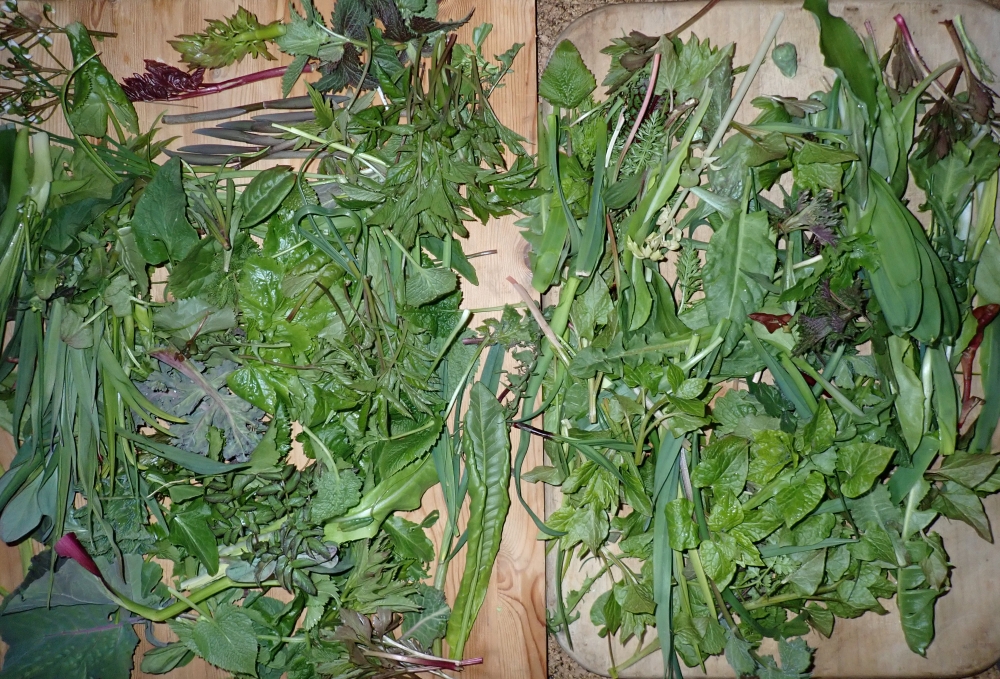
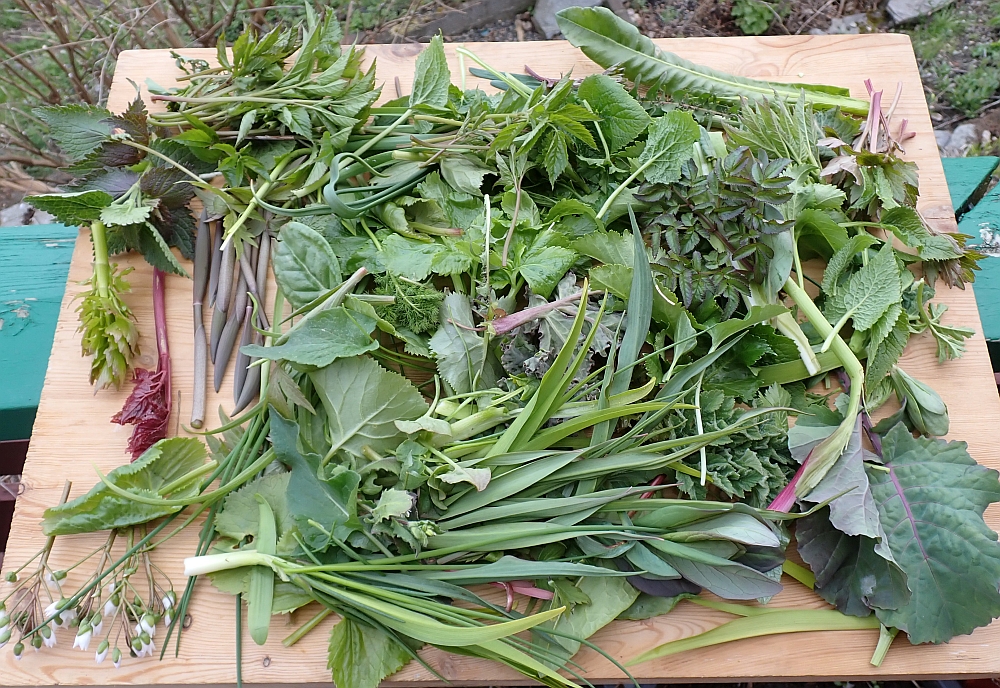
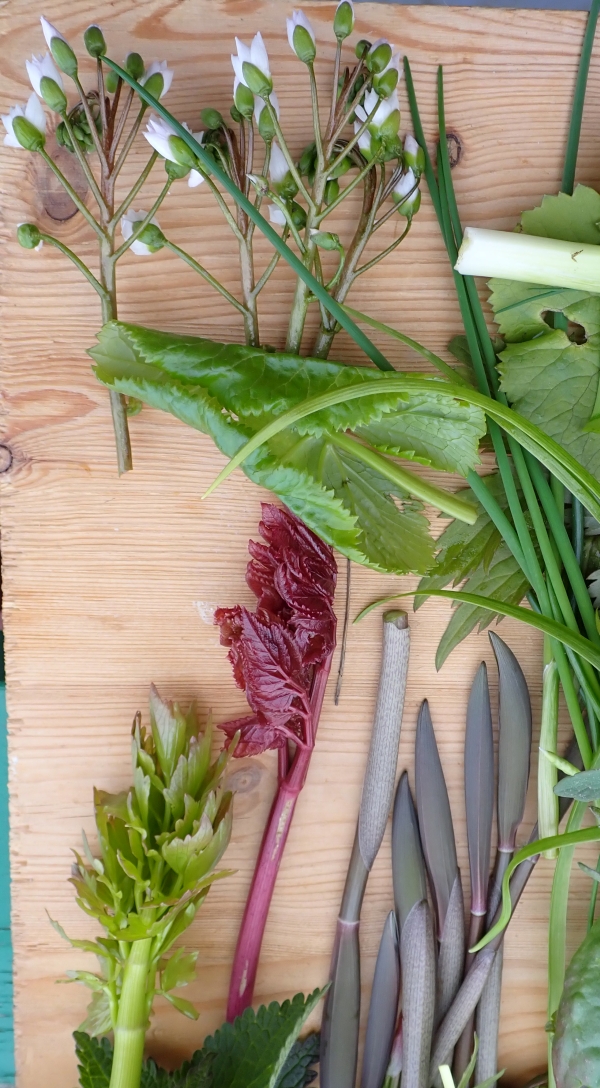

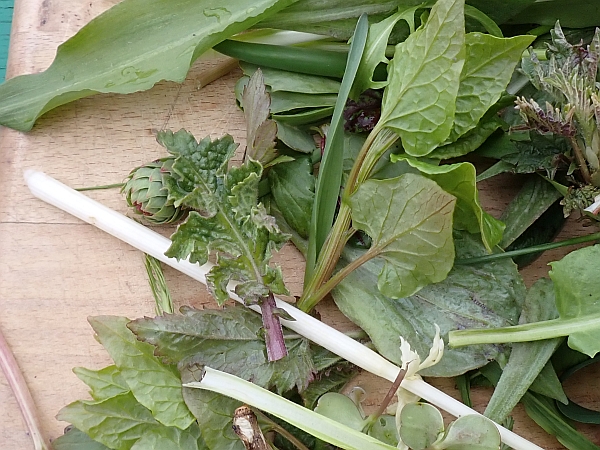
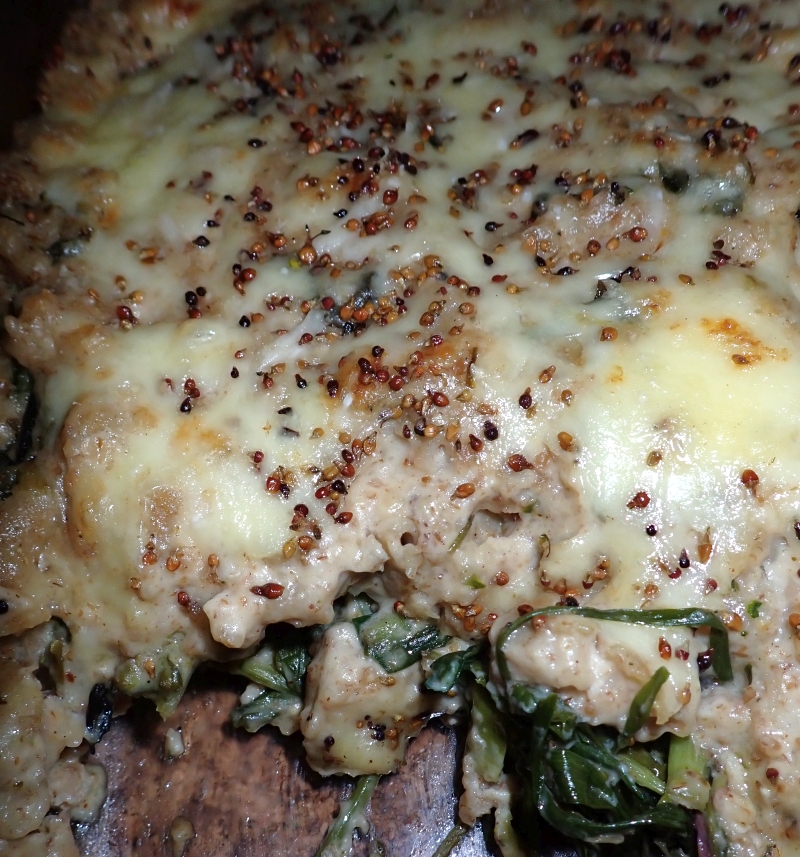






With record temperatures recorded in this area at the moment after a mild winter when all the cold spells coincided with good snow cover means that the soil was hardly frozen all winter and garlic shoots had appeared a few days ago at least two weeks earlier than I’ve recorded before and I also found the first ground elder (skvallerkål) shoots – welcome back my friend and, be warned, I will be eating you until the autumn!
It’s the marbled purple stripe garlic varieties that I grow that appear first: Aleksandra, Estonian Red, German Hardneck and Valdres!
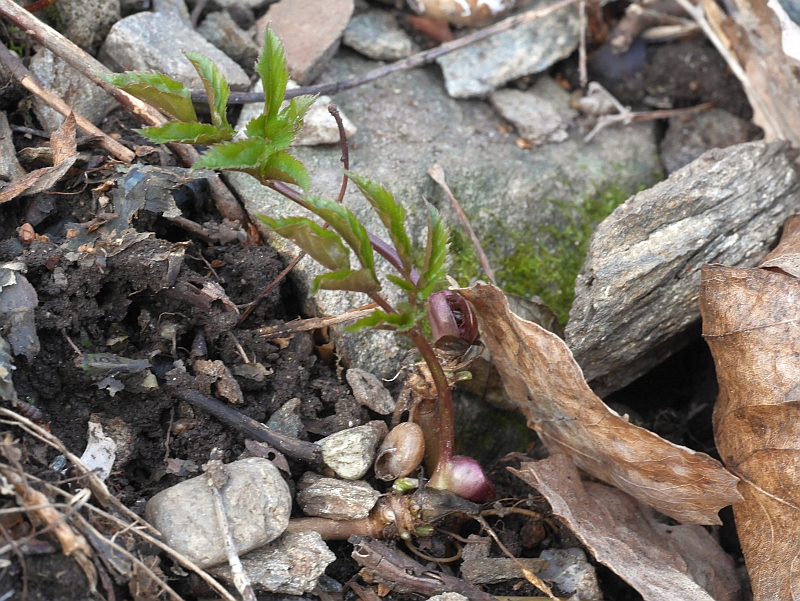
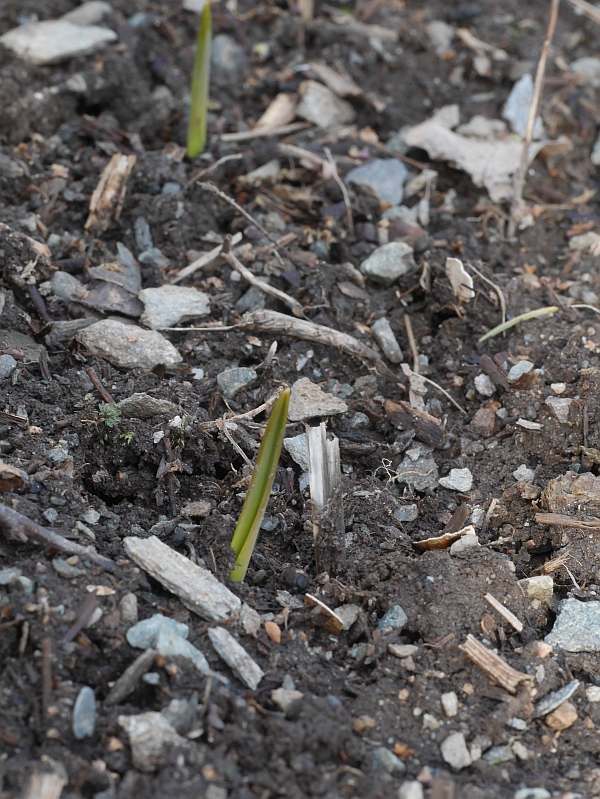
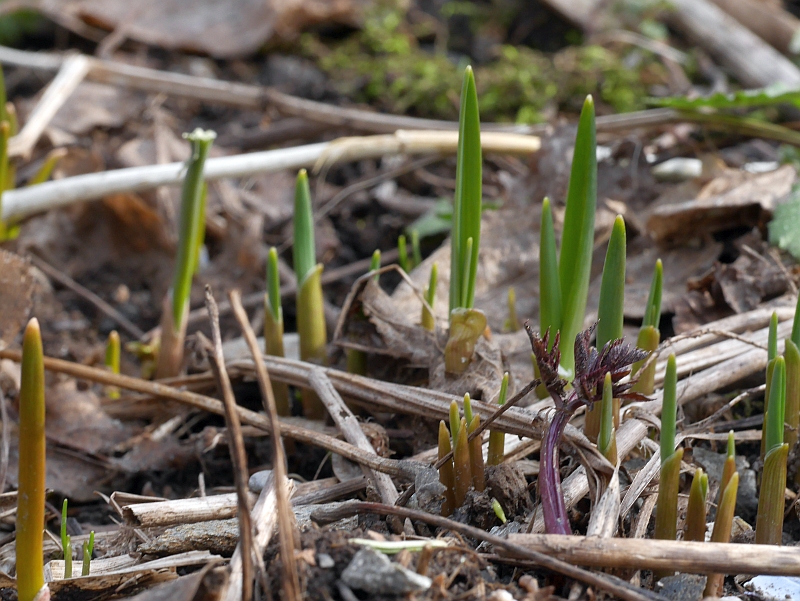
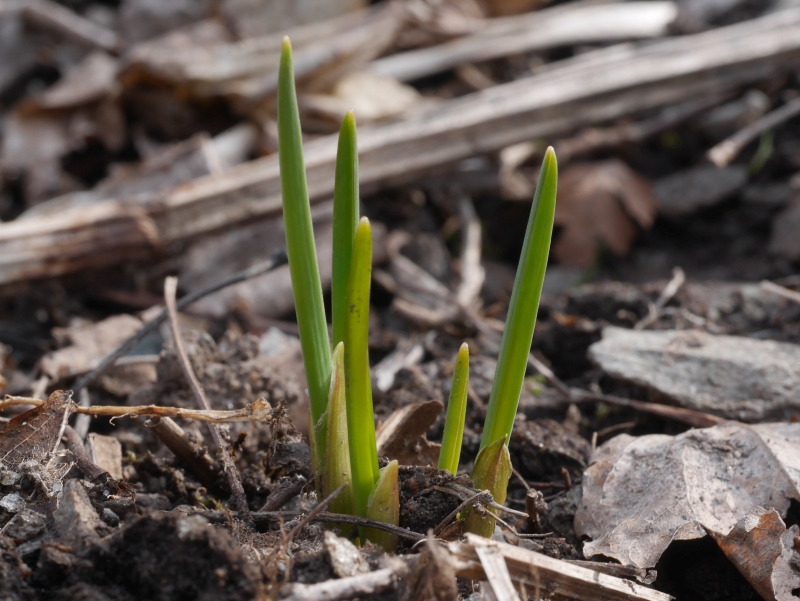
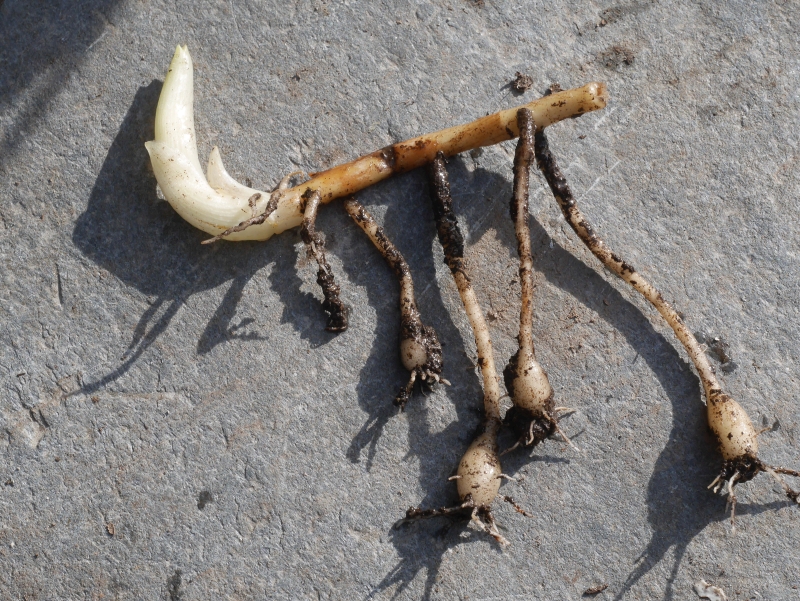

The Extreme Salad Man has been quiet recently. He was inspired to make this 5th November salad by a 10 year old Facebook memory of a salad he made (last picture below). Like 10 years ago, we¨’d had a very mild autumn (we may have the first frost this weekend). By chance the number of ingredients equalled the number of years I’ve been on this beautiful planet (66). For the recipe with the full list of ingredients (many are perennials), see the bottom of this post. It took less than an hour to forage around my garden and put together!
THE RECIPE or how to make this at home?
Harvested first around the living room a few Basella alba leaves, lemony flowers of two Begonias, leaves of the Okinawan spinach (Gynura bicolor), a couple of flowers of blackcurrant sage / solbærsalvie (Salvia microphylla v. grahamii), Ragged jack kale (grønnkål) leaves, leaves of chopsuey greens / kronkrage (Glebionis coronaria), four different perennial kales / flerårige kåls (Brassica oleracea), leaf shoots of Egyptian onion / luftløk (Allium x proliferum), a few leaves of common sow thistle / haredylle (Sonchus oleraceus), perennial rocket / flerårige rucola (Diplotaxis tenuifolia), parsley / persille leaves (Petroselinum crispum), leaves of Chicory / sikkori variety “Catalogna gigante di Chioggia” (Cichorium intybus), berries of black chokeberry / svartsurbær (Aronia melanocarpa), flowers of hollyhock mallow / rosekattost (Malva alcea), flowers of two varieties of hollyhock / stokkrose (Alcea rosea) – black and pink, hedge mustard / løkurt (Alliaria petiolata), mouse garlic (Allium carinatum), two varieties of dandelion / løvetann (Taraxacum spp.) including moss-leaved, flowers of Japan thistle (Cirsium japonicum), leaves of Allium senescens, a few of the last blackberries / bjørnebær (Rubus fruticosus), berries of black nightshade / svartsøtvier (Solanum nigrum), flowers of Allium mairei, flowers and leaves of anise hyssop / anisisop (Agastache foeniculum), flowers of two varieties of hardy Fuchsia / Magellan-tåre (Fuchsia magellanica) “Alba”og “Tricolor”, Autumn olive / Japansk sølvbusk (Elaeagnus umbellata) berries, radish / reddik (Raphanus sativus)flowers and unripe seed pods, flowers and flower buds of mustard greens / sennepsalat (Brassica juncea), a flower of marigold / ringblomst (Calendula officinalis), new shoots of curled dock / krushøymol (Rumex crispus), leaves and bulb of nodding onion / prærieløk (Allium cernuum), flowers of two varieties of nasturtium / blomkarse (Tropaeolum officinale), two varieties of spring onions / vårløk (Allium cepa), a few leaves of two varieties of sorrel / engsyre (Rumex acetosa), flower buds and flowers of chives / gressløk (Allium schoenoprasum), two leaves of chicory / sikkori variety “Rossa de Treviso” (Cichorium intybus) on the edge of the salad bowl, leaves of perennial chicory (Cichorium intybus), leaves of horned violet / hornfiol (Viola cornuta “Alba”), leaves of Rumex scutatus “Silver Shield” (buckler-leaved sorrel / Fransksyre), a flower of a reflowering variety of strawberry / jordbær (Fragaria x ananassa), flower shoot of scorzonera / scorsonnerot (Scorzonera hispanica), seen in the centre of the salad, a flower of Begonia “Double White, a Dahlia (georginer) flower, oca leaves (Oxalis tuberosa), tomato / tomat “Ida’s Gold” (Lycopersicon esculentum), berries of Physalis “Indian Strain”, two varieties of celery / selleri (Apium graveolens), berries of Ribes divaricatum “Worcesterberry”, carrot / gulrot, turnip / nepe and garlic / hvitløk!
Put the flowers and other colourful ingredients to one side for the topping, wash, cut (I use scissors) and mix everything else for the main body of the salad, add the salad dressing (olive oil, salt, pepper and vinegar with crushed garlic) and mix, then use the artist in you to decorate the salad!
A few unusual vegetables this October from the Edible Garden and House:
1. I’ve been trialling around 20 different chicories this year from seed from the German seed bank IPK Gatersleben. This is one of the best producers, Sugar Loaf (Accession CICH 350) which ended up in yesterday’s Basella and Chicory pizza! I remember years ago on a work meeting in Venice enjoying a chicory pizza.

2. Gunnera tinctoria is the representative for South America in my book Around the World in 80 plants. Sadly, it is not very hardy and mine grows in a large pot half submerged in my small pond and is moved into the cellar for the winter where it goes to sleep for most of the winter. The edible leaf petioles don’t reach the size of plants grown outside and are therefore a bit more fibrous. Their crunchy texture and sweet-sour taste was nevertheless a good addition to a mixed salad earlier in the week. 

 3. This summer was the first time I’d grown Okinawan spinach (Gynura bicolor). I cut it down earlier this week and used the leaves in the mixed salad together with the Gunnera. It’s the variety with red undersides to the leaves. Thanks to my friend Kim Jacobsen who leads KVANNs Stueplantelaug (Norwegian Seed Savers’ (Edible) House Plant guild) for sending me cuttings. It looks and tastes good!
3. This summer was the first time I’d grown Okinawan spinach (Gynura bicolor). I cut it down earlier this week and used the leaves in the mixed salad together with the Gunnera. It’s the variety with red undersides to the leaves. Thanks to my friend Kim Jacobsen who leads KVANNs Stueplantelaug (Norwegian Seed Savers’ (Edible) House Plant guild) for sending me cuttings. It looks and tastes good!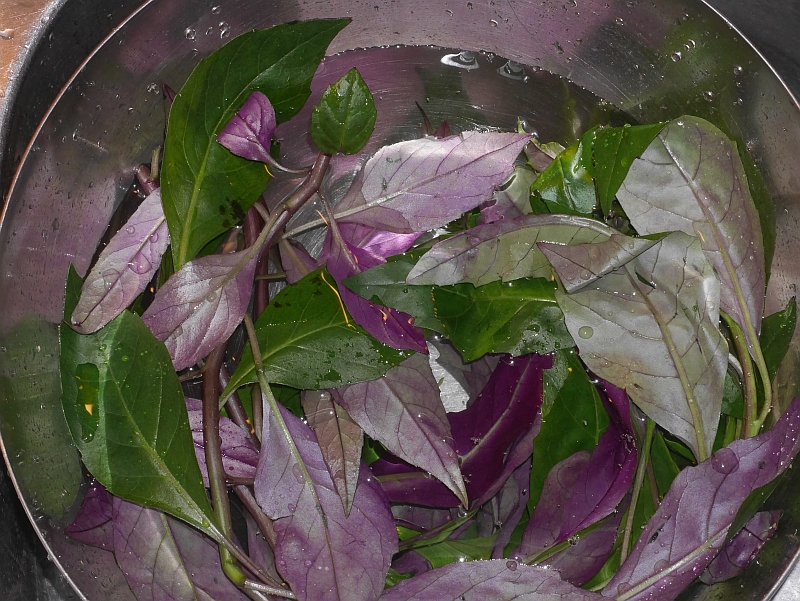

4. I also grow Basella (Ceylon spinach) inside and it always produces berries and seeds for the following year and for sharing. This was used with the chicory (above) in the pizza.
5. Autumn is also the time that the perennial kales resprout and provide an abundance of greens. Here’s a video of the perennial kales in the Edible Garden this week. I have another similar sized plot at the community garden.
6. One of my favourite wild edibles is common sow thistle / haredylle (Sonchus oleraceus), although I deliberately cultivate it. However, apart from posts by myself, this is a plant that isn’t mentioned in Norwegian foraging groups in Norway. Is this because it needs some preparation in order that it’s merits can be properly understood, the bitterness maybe putting people off at first taste? This is a plant I devote several pages to in my book Around the World in 80 Plants and I document how this is an important wild edible worldwide. My introduction to its merits was in the book Native Edible Plants of New Zealand by Andrew Crowe and on a work trip to that country in the early 2000s I could see for myself how important this plant is for the Maori people with over 1/3 of all the vegetable stalls selling this plant. Known as puha to the Maori, it has become a so-called cryptocrop* of the Maori vegetable gardens, an annual “weed” introduced by the Europeans with a similar taste to the traditional perennial endemic sea-cliff inhabiting puha (Sonchus kirkii). Annual puha is encouraged in between the main crops as it has a cash value and increases the yield of the land. It has also been suggested that the large consumption of annual puha by the Maori (hardly used by people of European descent) protects them against some forms of cancer. I was so inspired by the story of how a plant much hated worldwide could at the same time be a superfood appreciated by the Maori and all the other peoples around the world who are in the know, that I introduced it to my garden and it is now become my most important vegetable from late July to the first frosts! From it becoming a burden to weed out this coloniser of open soil, I now weed this “weed” leaving only a few plants to grow strong on the edges of my vegetable beds….and hate is turned to love! Much more in my book!
*Crytocrops: a distinction has been made between cryptocrops
from weeds by Diego Rivera et al. in a 2006 paper: “This led us to distinguish cryptocrops from weeds. Both are not cultivated plants living in crop fields and competing with the main crop. The fundamental distinction is the intensity of gathering by man”.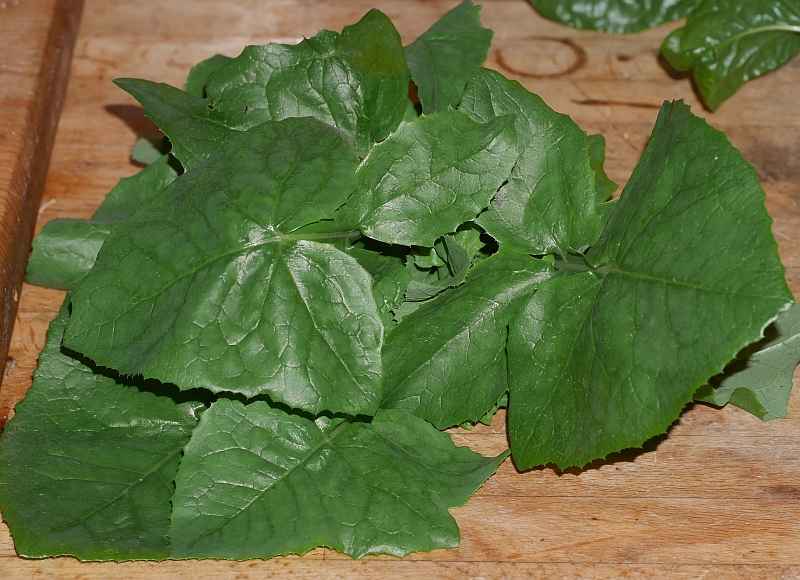 7. I have a special fascination for vegetables that are superstars in one part of the world but hardly known in their area of origin and one of those is garland chrysanthemum or crown daisy (Glebionis coronaria, early known as Chrysanthemum coronarium). This is a wild and extremely common flower of early spring in Mediterranean countries, often growing in large quantities, and commonly available in supermarkets in Japan where it’s known as shungiku. See more on this blog post Shungiku soba (a standard offering in soba restaurants in Japan): https://www.edimentals.com/blog/?p=22710
7. I have a special fascination for vegetables that are superstars in one part of the world but hardly known in their area of origin and one of those is garland chrysanthemum or crown daisy (Glebionis coronaria, early known as Chrysanthemum coronarium). This is a wild and extremely common flower of early spring in Mediterranean countries, often growing in large quantities, and commonly available in supermarkets in Japan where it’s known as shungiku. See more on this blog post Shungiku soba (a standard offering in soba restaurants in Japan): https://www.edimentals.com/blog/?p=22710
There is a legend that Marco Polo introduced pasta to Italy from China. In an article “Fra Malta til Japan og tilbake” (From Malta to Japan and back again) that I wrote 15 years ago for a Norwegian herbal magazine Grobladet in 2006, I suggested that Mr. Polo gave chopsuey greens in return (see and download the article here https://www.edimentals.com/blog/?page_id=3493).
When I first wrote about shungiku in 2006, I could only find one reference of its use in the Mediterranean for food. Since then, there have been carried out numerous ethnobotanical studies throughout the Mediterranean and a quick search carried out now revealed that this plant has been used traditionally throughout the area, although by no means a common wild edible:
In Turkey: numerous studies (leaves, young shoots and stems are used) have recorded this plant used as summarized in a paper from 2019 by İsmail Şenkardeş and others: “An Ethnobotanical Analysis on Wild Edible Plants of the Turkish Asteraceae Taxa”
In addition, it is recorded in two studies in Spain, in Morocco, Palestine and in Sicily it was both cooked and used in salads.
This plant fits nicely into my diversity cooking as it produces new shoots in smaller amounts throughout the summer from July to the first frosts and they are usable even after the plant has flowered and produced seed.
There are many cultivars with different flower colour, double and single and serrated and whole-leaved forms. I’ve grown some 10-15 different cultivars this summer, the seed from the collections at IPK Gatersleben in Germany.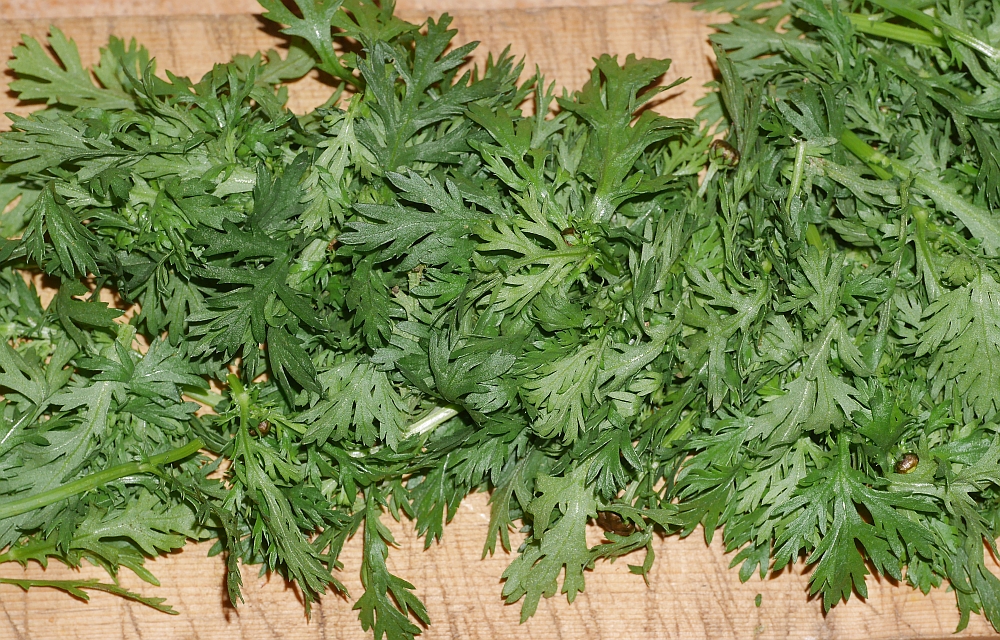

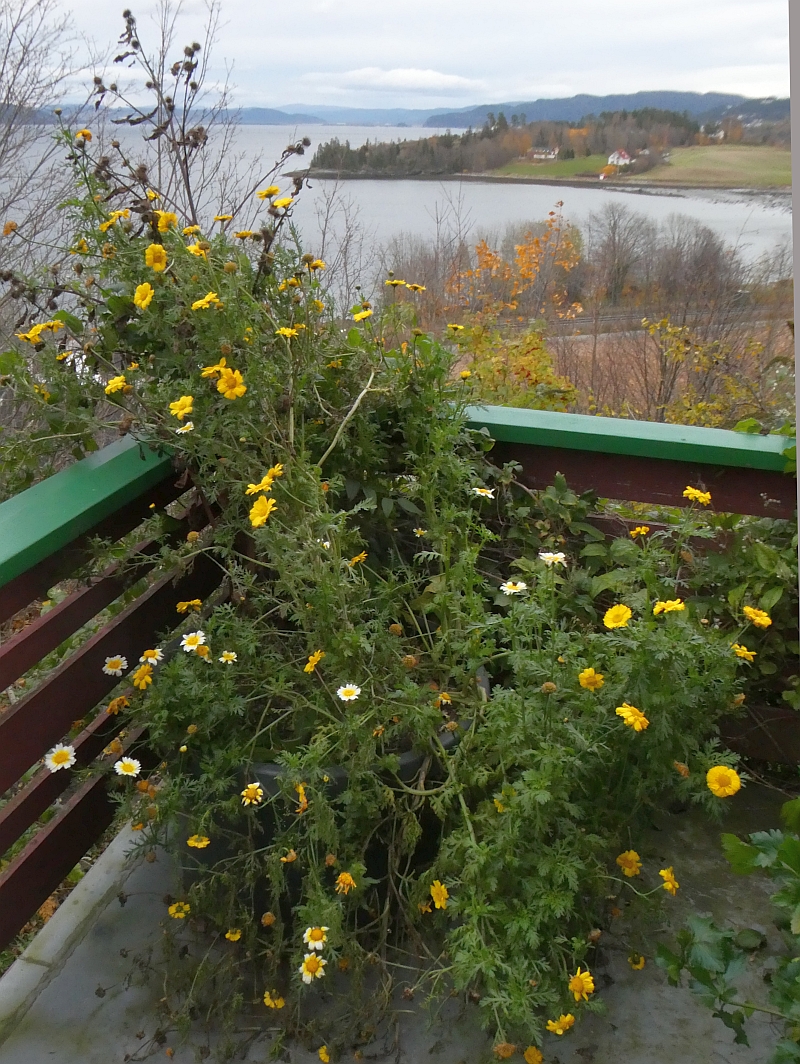
Alpine bistort or harerug in Norwegian (Bistorta vivipara syn Persicaria vivipara or Polygonum viviparum) is a common plant here in Norway and the only wild plant apart from berries that I forage every year. There are large quantities of this plant in particular in the mountains. It’s also one of the 80 in my book Around the World in 80 plants where you can read more. I enjoy it’s nutty taste on bread and other baked dishes like quiches (see https://www.edimentals.com/blog/?s=alpine+bistort)
However, the local alpine bistort here is a rather small plant, typically up to 20cm tall, and is difficult to cultivated as it competes badly with weeds and requires a lot of weeding. I’ve collected forms that seem to be more vigorous, but nothing as large as I’ve seen elsewhere in botanical gardens. In 2002, I found a plant closely resembling alpine bistort cultivated in the Hilliers Arboretum in Hampshire UK. However, it was significantly bigger than our plants. I planted a bulbil in a garden bed, but it spread quite aggressively, a bit like bistort (Bistorta officinalis) and I removed it again. It spread however into the adjacent grass and is still there (I haven’t noticed our native alpine bistort doing this in my garden). I had wondered if it was a different species at the time. Here’s a picture of it (a larger plant with large and many bulbils):
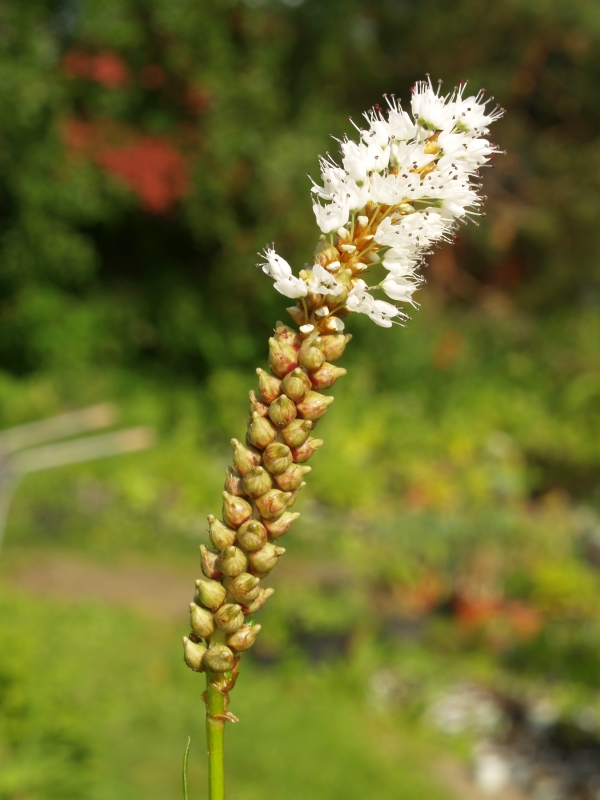
Returning to Hilliers in 2010, I saw another vigorous plant in 2010 (below), more closely resembling our Norwegian plants:


Then in 2017, I saw another viviparous plant, labelled Polygonum spp., in the Gothenburg Botanical Gardens and was given a few bulbils. I’ve grown that one on in a large pot and here are a few pictures taken today:
According to a paper in 2013: “Viviparous bistorts are represented by 3 species in the world, P. suffultoides An Jen Li (1995: 415), B. vivipara (Linnaeus 1753: 360) Gray (1821: 268) and B. tenuifolia”.
Tenuifolia has very narrow leaves and the description of suffultoides doesn’t fit my plant. Among other things it has pubescent leaves (hairs – on both sides).
I don’t have the accession data for my plant (I will try to find out from Gothenburg), but it does almost fit the description in Flora of China of one of the larger forms of Bistorta vivipara. My plant reaches 50cm (15-60cm in FOC); leaf blade 13cm long (3-10cm). The bulbils are large, but there are a larer proportion of sterile flowers, so the yield may not actually be much larger. The pink flowers are within the normal range and I have one variety from Norway with pink flowers. It could also be from North America where large forms exist (usually known as Bistorta vivipara subsp. macounii), reaching 45cm according to the Flora of North America; see http://floranorthamerica.org/Bistorta_vivipara)
I have today dug up a couple of tubers from the grass so that I can grow it out and complete the comparison. Watch this space.
Along with many members of the Apiaceae (carrot family / umbellifers) the flowers of Dystaenia takesimana (Giant Ulleung Celery) are heaven for pollinators like hoverflies (blomsterfluer).
These great edi-ento-mentals thrive both in sunny conditions and in the complete shade of this Buddleja davidii (butterfly bush / sommerfuglbusk).
For more on this great multi-purpose plant, see https://www.edimentals.com/blog/?p=24998
This year’s udo (Aralia cordata) selfie pictures, probably the highest ever with a flowering spike way above my head. I harvested about 1/3 of the shoots in the spring. This is my largest herbaceous perennial vegetable that was planted here 20 years old ago! It has never had any fertiliser and is growing on the steepest slope in my garden. Ostrich fern (strutseving) and giant bellflower (storklokke) can be seen in the foreground.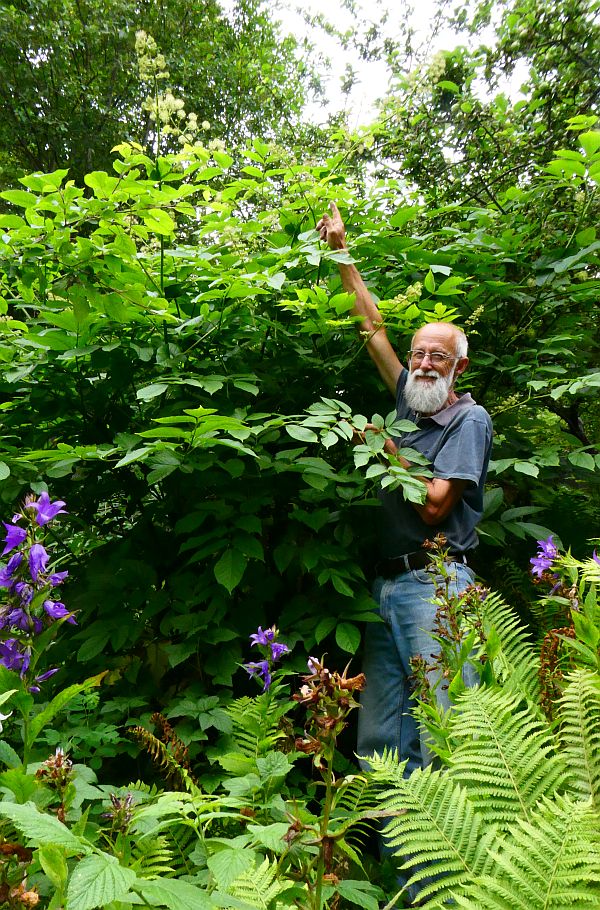
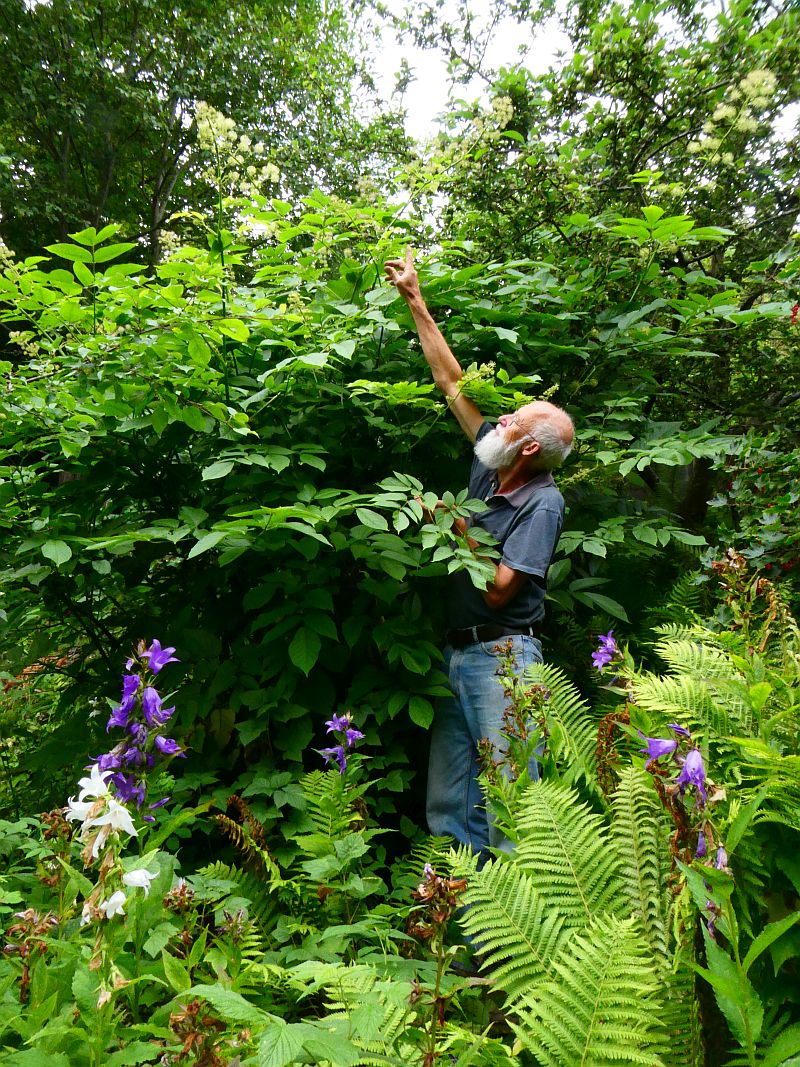
Like Sherpa onion or Nepalese onion Allium wallichii, which features in my book Around the World in 80 plants, chiugok (small bird’s garlic) as Allium macrantum is known in Lithang, Tibet is the latest emerging Alliums in my garden. I often wonder if they are still alive when, in a cold spring they haven’t emerged by the end of May, but both species have overwintered now for almost 20 years.

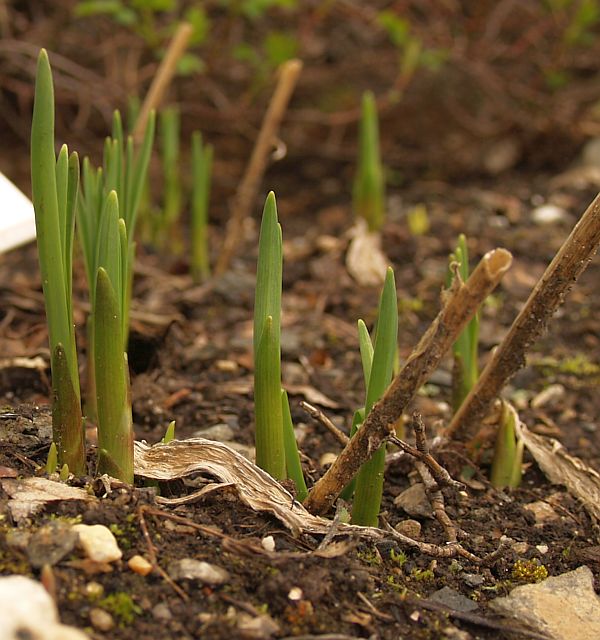
I’m not sure where my oldest plants came from but my second accession came from Vojtec Holubec’s seedlist, collected in Szechuan in China. It’s native to Bhutan, Sikkim, Gansu, Shaanxi, as well as Szechuan and Tibet and grows in wet places at elevations of 2700–4200 metres (Flora of China).
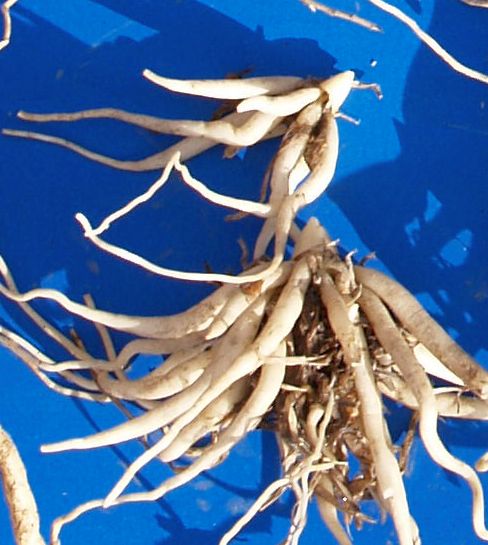
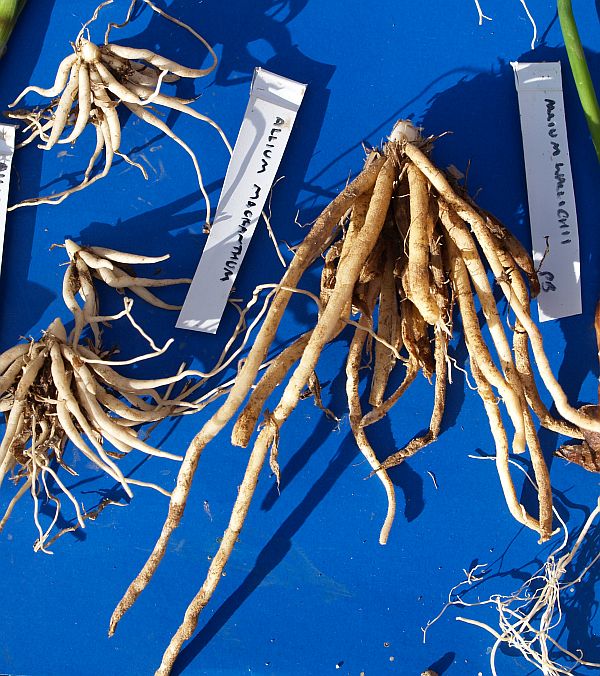
By early July the old roots are withering away and new roots are growing as the flower scape appears:

The flowers are gorgeous hanging on long pedicels. Note that the flower colour varies and the Szechuan accession is pink with green pedicels and has relatively many flowers.
One of my multi-species salads with Allium macranthum flowers in the centre:
Seed heads on 6th September:
Seeds ready to share or trade:
Ethnobotanical records
I searched Google Scholar for evidence of Allium macrantum being used traditionally for food and there were indeed a few ethnobotanical studies recording its use as a food plant. Although not the most popular food Allium in the Himalayas, it is reported to have been one of several species eaten both in Arunachal Pradesh in North East India, the Eastern Hills of India (along with more commonly used Allium wallichii, Allium hookeri and Allium fasciculatum) and used as a spice with meat in South Central Tibet. In Lithang, chiugok “is cleaned and cut into small pieces. It is mixed with butter, tea, roasted barley flour (tsampa), salt, and chilly. Tsampa may not be added. The sauce so obtained is eaten with Tibetan dumplings (mokmok) and fried meat-filled pancakes (shapakle)” (in Traditional knowledge of wild food plants in a few Tibetan communities).
The taste is in my experience relatively strong and therefore best in mixed salads and cooked dishes.
Allium macranthum has also been moved into gardens as an ornamental and has also been used medicinally, including, along with other Allium species, as a cure for altitude sickness!
Here are some of the vegetables we’re currently using.
From left to right:
Common sow thistle / haredylle (Sonchus oleraceus) will be in most meals from now to September
Parsley / persille
Ground elder / skvallerkål
Perpetual spinach (Beta vulgaris var flavescens)
Moss leaved dandelion (Taraxacum sublaciniosum “Delikatess”)
Oregano / bergmynte (Origanum vulgare)
Chopsuey greens (Glebionis coronaria); I’m growing out about 10 varieties from IPK Gatersleben this year
Day lily / daglije (Hemerocallis): flower buds from two species
Urtica kiovensis (nettle / nesle)
Nodding onion / Prærieløk (Allium cernuum) flower scapes
Hablitzia tamnoides (Caucasian spinach / stjernemelde) leaves
Rumex patientia (Patience dock / hagesyre)
Rumex acetosa (non-flowering); sorrel / engsyre
Perennial kale / flerårig kål (Brassica oleracea)
Dandelion / løvetann (Taraxacum officinale)
Sherpa or Nepal onion / Sherpaløk (Allium wallichii)
Used in a green pasta sauce with wholegrain spelt pasta